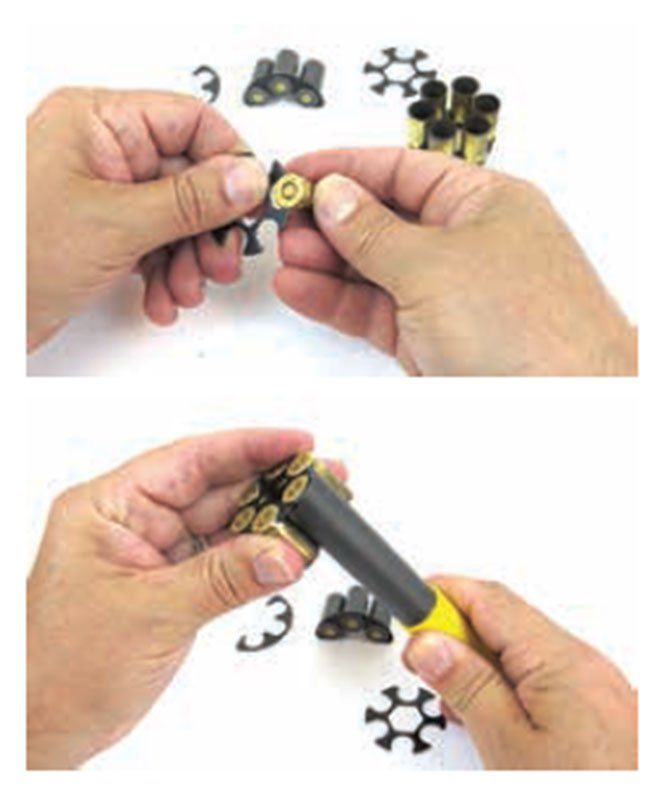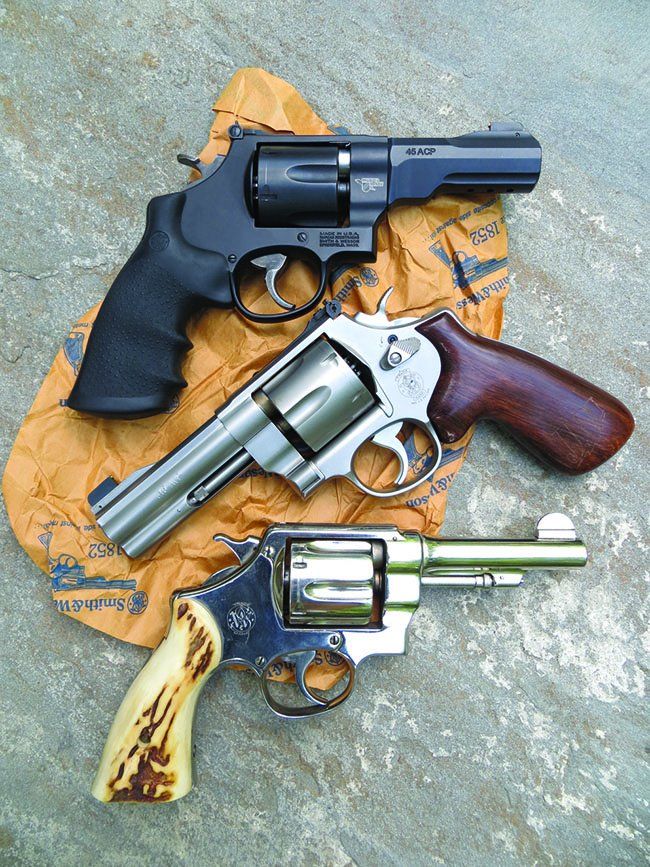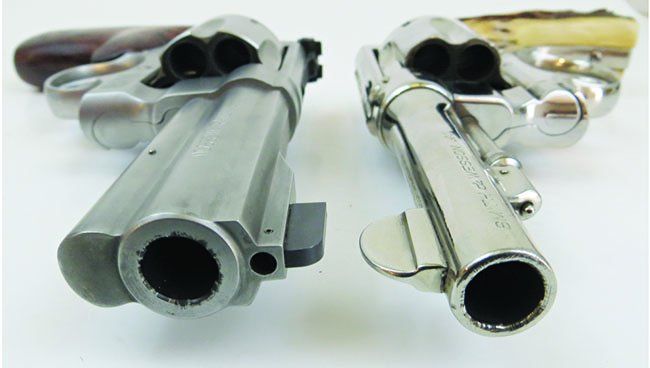
Shooting the 45 ACP cartridge in a revolver may seem like an oxymoron, but the round has a long history of being matched up in revolvers starting at the turn of the 20th century. The issue in 1917, other than World War I, was a dearth of the new M1911 pistols as the U.S. became involved in the war. Tooling up for 1911 production was not an option since it would cost too much time. Remember, at the turn of the century, revolvers ruled the roost and all manufacturers were building double-action revolvers. With plenty of 45 ACP ammunition in inventory, the U.S. military turned to Colt and Smith & Wesson, which chambered the 45 ACP in their heavy frame revolvers.
S&W is credited with the idea of using moon clips, because there’s a trick to firing the rimless 45 ACP cartridge in a wheelgun. Revolvers use rimmed cartridges, which headspace on the rim. Rimless pistol cartridges headspace on the case mouth. Insert a 45 ACP in the cylinder chamber and it will fit and probably fire the round. But the issue now becomes, how does the shooter eject the cartridge? The solution S&W came up with was a moon clip that holds six rounds, or a half-moon clip that holds three rounds. Both Colt and S&W used moon clips in what the U.S. Military named the United States Revolver, Caliber .45, M1917. We tested one of these old warhorses against two other generations of 45 ACP revolvers recently to see if the relic stood the test of time.

A newer generation is the S&W Champion Series Model 625-8 JM, with the JM standing for Jerry Miculek. This is the revolver that Mr. Miculek uses to shoot un-Godly fast; it took him 2.99 seconds to fire six shots, reload and fire six more shots with this model revolver. Testers really liked this revolver, though it seemed the plainest of the three revolvers, looking a lot like a Model 686. This revolver is very popular with IDPA shooters and other competitors. Now we know why — it loved to be run and run hard at the range.
The newest generation is the S&W Performance Center Model 325 Thunder Ranch, which is constructed from lightweight materials and offers a few modern updates on revolver design, which we thought were good intentions. But we learned we did not like having an accessory rail under the barrel. It’s a good idea to incorporate a tactical light or laser sight onto a revolver via an accessory rail, but it’s a bad idea to have the rail in a place that could potentially injure the shooter. More on that in a minute.
We looked at these N-frame revolvers through two lenses, one being defensive and the second being competitive. As testers pawed over the three revolvers, comments on the 45 ACP 6-shooters ranged from “novelty” and “antique” to “convenient” and “practical.” The 1911 shooters leaned toward the positive end of the grading spectrum, while others seemed bothered to shoot a semi-automatic cartridge in a revolver. Nonetheless, we put the wheelguns through their paces, and here’s how the generations fared.
Smith & Wesson M191745 ACP, $600-$800
The M1917 we acquired had been modified. The S&W roll mark on the barrel was not centered, which was a clue this revolver had some work done to it. The end of the barrel was cut down, and the round front-blade sight was re-soldered onto the barrel. It had a chrome finish, the lanyard loop was removed, and a pair of stag-horn grips replaced the original checkered wood grips. Evidently, TED — the initials or first name of the former owner are engraved on a brass plate soldered to the butt to cover the lanyard hole — wanted a barbecue gun. That is, a gun that creates conversation where smoked meats are consumed.
Original S&W M1917s had a 5.5-inch barrel and were blued. After WWI, arsenal-refinished models may have a Parkerized finish. S&W built the M1917 using the Second Model 44 Hand Ejector, which was originally chambered in 44 Special and then 455 Webley for use by British troops during WWI. The M1917 used a shortened cylinder with chambers machined with a shoulder so that 45 ACP cartridges headspaced on the case mouth like they do on semi-automatic pistols. It was possible, but not practical in combat, to separately load 45 ACP cartridges into the chambers of S&W M1917 revolvers and fire the rounds. Empties, however, needed to be pushed out from each individual chamber using a rod. Tedious, but doable, as we found out. Moon clips were far easier and efficient. Moon clips come in six-round, three-round and two-round sets. We tested with six- and three-round clips.
A dozen or so moon ($1.40 each) and half moon ($2.25 for a pair) clips were ordered from Numrich Gunparts Corp.along with a case removal tool ($10.65). We became very proficient at quickly loading clips and unloading clips using a tool. We also became very proficient at destroying half moon clips while trying to remove empty cases. The cartridge removal tool was a notched tube. The tube held six cartridges, and after each clip was unloaded, empties were dumped into our reloading bucket. We felt the half moon clips were nostalgic and easier to conceal for a reload when carrying concealed, but the loaded full-moon clips, though bulky in a pocket, were fast to reload. We found that we could come close to the same reload time as we have with a semi-automatic pistol, just with reduced round counts.
For 45 ACP ammo we chose two 230-grain FMJ factory loads — Hornady Steel Match and Winchester white box — and a reload using 185-grain SWC bullets, which we use for training and competition. We also found a source for 45 Auto Rim ammo by American Custom Ammoloaded with a Rainer 200-grain TMP/FN/FB bullet. The 45 Auto Rim cartridge was developed around 1920 by Remington-Peters specifically to fire in M1917 revolvers without the use of clips. These cartridges have a thick rim and headspace on the rim. They were loaded to 45 ACP military standards.
The M1917 was still in good condition even for its age. The lock up was tight with little wiggle. The cylinder locked in the rear and in the front via the ejector rod and a pin set in the under lug. The end of the ejector rod had a belled end, so slamming your palm on it to eject empties was comfortable. Opening the cylinder, we noticed the stepped chambers. The ejector center pin also allowed the moon clip to drop over it. In hand, the revolver had a nice heft, and the stag-horn grips were hand filling with plenty of texture — decorative and usable — though noticeably shorter than the grips of the other revolvers.
Since the gun was chromed and the sights were fine, it was like looking into the sun when firing at times, especially when the sun glinted off the chrome finish.

The action needed some attention, as the revolver was difficult to cock single action, and with the small hammer spur and minimal knurling, we had the feeling the hammer would slip, but it never did with any of our testers. The trigger was also smooth and thin. We assumed a range rod would find this gun out of spec, but it passed. We also assumed at the range we need a large piece of cardboard to find where the bullets were hitting, and we were quite wrong. It gave impressive groups and bested the new Model 325 TR by a significant margin. This pistol was a shooter if you took the time to align the fine sights. In double action, the M1917 was harder to control than the other two revolvers. Most testers shot the M1917 well, but we simply shot the other revolvers better. The ejector rod pushed empties well out of the cylinder chambers with ease. Loading with either moon clip was fast.
Our Team Said: We appreciated this old revolver, and shooting it helped us better understand how these revolvers evolved. This chopped up M1917’s mechanism needs to be looked at by a gunsmith prior to purchasing, but if it passed, then we’d get a tooled leather holster and matching belt for informal shooting. Since the M1917 was modified, it had lost all collector value, and though it was a nostalgic shooter, it was too dated for serious defense or competition.
Smith & Wesson Champion Model 625-8 JM 160936 45 ACP, $979
The Model 625-8 JM (Jerry Miculek) revolver is one of S&Ws Champion Series revolvers designed in collaboration with professional shooter, Jerry Miculek. The initials JM and a lightning bolt were engraved on the sideplate and on the grip; other than that it looked like a husky Model 686. The 686 uses S&Ws medium size L-frame; the 625-8 JM is a large N-frame. Jerry Miculek uses a modified S&W 625 with a 5-inch barrel for USPSA/IPSC competition and a different 625 JM, similar to the one tested, which is also modified for IDPA matches.
As a competition revolver, the 625-8 JM was well set up. In fact, it is one of the most popular revolvers at IDPA matches in the Stock Service Revolver division. This revolver is designed to run and run hard. A rapid-fire drill conducted on all the revolvers had shooters with revolvers in hand pointed down range at a 45-degree angle at an IDPA target 15 yards away, then we fired six shots, reloaded, and fired six more. The 625-8 JM was the fastest of all the revolvers. We also wore the 625-8 JM as our daily conceal carry with a Safariland Model 567 belt rig – we used the same holster for all three revolvers – and found the setup to our liking, though the 325 revolver was more comfortable to tote due to its light weight.
The range rod test proved all chambers were aligned with the barrels bore. It dropped through with ease. The lock up was tight with minimal wiggle. The 625-8 was equipped with a small cylinder latch which worked precisely, giving testers confidence in the revolver. The trigger was wide and grooved, and the trigger pull was slick making the double-action pull feel less than what it measured. There was no trigger stop, which is one feature we thought would plus up the 625-8 JM.
The fit and finish on the 625-8 JM was superb. The grip fit the frame well, and the matte stainless finish was pleasing to the eye and functional. We saw no glare when shooting in the sun. The rear sight was adjustable and matte black. The front sight blade wore a gold bead and was interchangeable. Both the 325 TR and 626-8 JM had similar sights, which testers liked on both guns. Some would replace the front blade immediately, but all agreed the sight picture was good and fast to acquire.
Testers suspected the smooth grips would be too slick, allowing the revolver to move during recoil, especially in rapid fire. They also assumed the felt recoil from the wood grip would be noticeable. What we found is the revolver had a perfect combination of heft to help absorb recoil. In rapid fire, testers grew to like the grips and found they could get a higher hold on the revolver, and we did not experience slippage with the grip. We didnt beat any fast-shooting records, but we were able to quickly fire the revolver. Reloading was fast with the moon clips, and the ejector fully pushed empties clear of the cylinder. The longer ejector rod was favored by our testers.
We would chamfer the chambers, like the 325s chambers, to make loading faster. The thick-rimmed 45 Auto Rim cartridges are loaded one at a time and quickly showed testers the speed of reloading with moon clips.
With Winchester White Box and Hornady Steel Match, both loaded with 230-grain bullets, we were able to get 0.2-inch six-shot groups when we did our part. The 45 Auto Rim cartridges also gave similar groups in the 625-8 JM. That impressed us.
Our Team Said: We would not hesitate to purchase the 625-8 JM and use it in competition or as a defense weapon. It was a pleasure to shoot and is a bargain, in our opinion.
Smith & Wesson Performance Center Model 325 Thunder Ranch #170316, $1329
The Model 325 TR is the newest design. This revolver was built with input from Thunder Ranch honcho Clint Smith and wears the Thunder Ranch logo in white on the right side of this matte black revolver. The 325 TR comes out of the Performance Center with a steel barrel covered with a sculpted aluminum sleeve, scandium alloy frame, and stainless-steel cylinder. It weighs about 31 ounces, the lightest of all revolvers tested. Fit and finish of the metal was excellent. Since all of these revolvers are N-frames, the 45 ACP cylinder looks too small for the frame, and in the case of the 325 TR, because of the way the barrel is assembled, the steel barrel and cylinder gap can be held to a close tolerance.
The front-sight blade wore a gold bead; a night-sight dot would have been better, according to some testers. The blade can be replaced, and that was a nice feature. Especially since this revolver is designed for defensive work. The rear sight was plain black; some thought a white outline would be better; the same comment was made of the 625-8 JM. The back side of the rear sight was serrated to reduce glare, a good touch.
The 325 TR uses a ball detent lockup at the front of the crane that solidly locked into the frame, which we liked. The ejector rod was short compared to the other revolvers and enclosed in a streamlined under lug. The stubby ejector rod was similar to rods found on snubnose revolvers. We became proficient with the set up, and, as always, used gravity to help unload the revolver. The rod was short due to an accessory rail that could be attached to the underside of the barrel for adding a tactical light or laser sight. We did not like this set up since it required our hands to be close to the cylinder gap and hot gases. If we were operating a light or lasers activation button/switch and needed to fire at that moment, then our hand was in jeopardy of getting a blast of hot gases. We dont think the gases are as severe as a plasma torch, but it might be enough to temporarily put us out of action. If we were to use the rail and a light setup, we would need extra training to become proficient.
Range rods freely fell through the barrel and into all the cylinders. Accordingly, we anticipated that this revolver would be an accurate shooter. We were wrong. The accuracy with the Model 325 TR was mediocre with the 45 ACP and 45 Auto Rim ammo we had on hand. We were not impressed. The 325 TR also had the most felt recoil of all the revolvers, due to its light weight.
The grips also rubbed our fur the wrong way for such a tricked-out piece. The grips had gaps between the gun side of the grip and the frame. Weve fired big-bore revolvers with these style grips before and had a good experience. With the 325 TR, we found in rapid fire the light weight of the revolver and the grips did not help with accuracy. We felt beat up after firing the 325 TR.
The 325 TR was fast to load and reload; the chamfered chambers helped increase reload speed, our team said. The smaller cylinder latch proved easy and fast to use. Looking at the data, the 325 TR seems to prefer lighter bullets. Part of the efficiency with these revolvers is to use the same ammo used in a 1911 or other 45 ACP semi-automatic pistols, and the ammo tested was ammo we regularly use in our 1911s and Glocks.
Our Team Said: The light weight made this a nice carry. For competition, we would prefer a heavier revolver. Testers wanted to like the 325 TR because it had striking looks, but in use it did not perform to expectations, especially for the price. Thus, we would pass on the 325 TR. We appreciated the weight and excellent lock work, but its accuracy left us wanting more. We would also deep-six the accessory rail and get new grips if we owned this revolver.
Written and photographed by Robert Sadowski, using evaluations from Gun Tests team testers. GT
SW_Model_1917_45_ACP_600800.pdf
SW_Champion_Series_Model_6258_JM_160936.pdf































